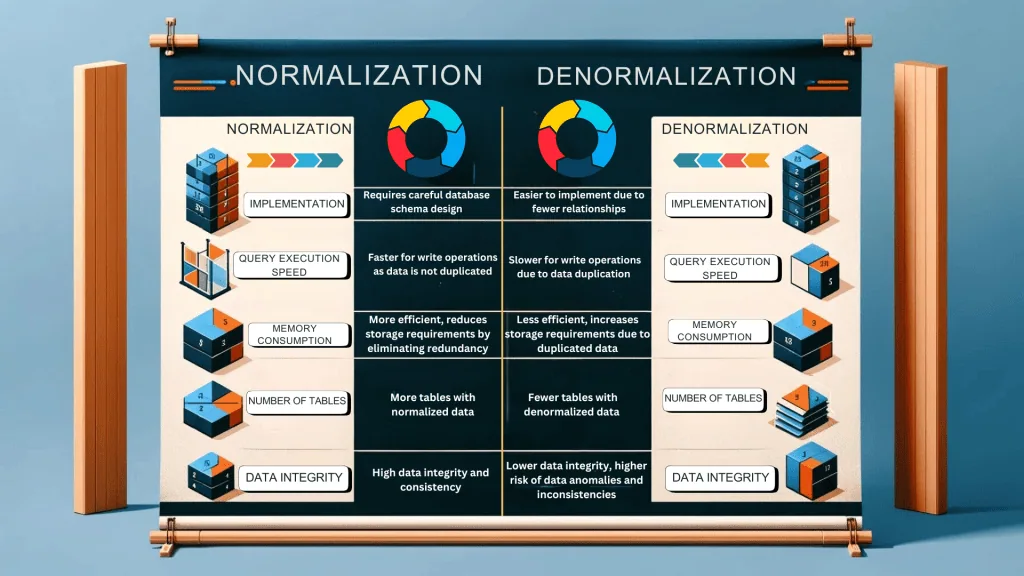Database Optimization For Developers: Enhancing Performance and Scalability
Reading time: 10 minutes
Table of Contents
- Understanding Backend Frameworks
- What is a Framework?
- Key Strategies for Database Optimization
- 1. Indexing
- 2. Query Optimization
- 3. Normalization and Denormalization
- 4. Caching
- 5. Database Maintenance
- 6. Choosing the Right DBMS
- The Role of Authentication in Database Optimization
- Authentication Methods
- Identity Authentication
- User Authentication
- Phone Password Ideas
- Integrating Backend Frameworks with Database Optimization
- What Does Framework Mean in This Context?
- Final Thoughts
Effective database optimization is crucial for ensuring high performance and scalability in applications. Developers must continuously seek ways to refine database interactions to handle increased loads and reduce latency. In this article, we will explore key strategies for database optimization for developers that can lead to more efficient applications. Additionally, we will delve into the importance of backend frameworks and how they integrate with databases to create robust web development frameworks. Elementor is also a useful tool in web development, offering features that can complement these frameworks.

Understanding Backend Frameworks
Before diving into the specifics of database optimization, it’s essential to understand what is a framework, especially in the context of backend development. A backend framework is a software framework that provides the foundation and structure for building and maintaining web applications. These frameworks streamline the development process by offering reusable components and tools, which help developers focus on writing business logic rather than reinventing the wheel. Elementor plays a vital role in front-end development, which often needs to be aligned with backend optimizations.
What is a Framework?
A framework is a set of tools and libraries designed to simplify and accelerate the development of software applications. In web development, backend frameworks are crucial as they handle server-side operations, database interactions, and application logic. Examples of popular backend frameworks include Django, Ruby on Rails, and Laravel. Integrating Elementor with these frameworks can enhance the overall user experience by bridging the gap between front-end design and backend functionality.

Key Strategies for Database Optimization
1. Indexing
Proper indexing is one of the most effective ways to speed up data retrieval. Indexes provide a quick pathway to the data you’re searching for, much like a book’s index allows you to quickly find specific information. However, over-indexing can slow down write operations, so it’s crucial to find a balance.
Indexes work by creating a data structure that improves the speed of data retrieval operations on a database table. When a query is made, the database engine can use the index to quickly locate the desired rows without scanning the entire table. Database optimization for developers is crucial, especially when dealing with large datasets, as indexing can significantly enhance performance. While indexing is beneficial for read-heavy databases, it’s important to manage them carefully as each index can add overhead to data modification operations such as insert, update, and delete.

2. Query Optimization
Writing efficient queries is fundamental. This includes selecting only the necessary columns rather than using SELECT *, avoiding multiple joins in a single query if not necessary, and using query execution plans to analyze performance. Also, ensure that queries are using the most efficient order of operations.
Query optimization involves various techniques to ensure that the database engine executes queries in the most efficient way possible. Using query execution plans, developers can see how the database engine intends to execute a query and identify potential performance bottlenecks. Optimizing queries not only improves performance but also reduces the load on the database server, making it more responsive to other requests.
3. Normalization and Denormalization
Normalization reduces redundancy and improves data integrity by organizing databases into well-defined tables. Conversely, denormalization can sometimes improve performance by reducing the number of joins needed. The key is to strike the right balance based on the specific use case and load patterns.
Normalization involves organizing the data in the database to minimize redundancy and ensure data dependencies make sense. This process often involves dividing large tables into smaller, related tables. Database optimization for developers includes techniques such as denormalization, which involves combining tables to reduce the number of joins required in queries, which can improve performance at the cost of data redundancy. The choice between normalization and denormalization should be driven by the specific performance needs and access patterns of the application.

4. Caching
Implementing caching strategies can drastically reduce the number of times a database needs to be queried. Cached data is stored in a ready-to-go state and can be fetched much quicker than data queried from the disk. Examples of caching mechanisms include Redis and Memcached.
Caching involves storing frequently accessed data in a temporary storage area so that future requests for that data can be served faster. By reducing the need to query the database for frequently requested information, caching can significantly improve application performance and reduce the load on the database server. Properly configured caching, especially when combined with database optimization for developers, can lead to faster response times and a more scalable application.
5. Database Maintenance
Regular maintenance practices such as updating statistics, rebuilding indexes, and cleaning up old data can help keep the database performing well. Scheduled maintenance ensures that the database remains optimized for both read and write operations. Additionally, developers and digital marketers can explore the best SEM tools for monitoring and optimization to track performance, visibility, and keyword impact—bridging technical and marketing insights.
Database maintenance involves various tasks that keep the database running smoothly and efficiently. Updating statistics helps the database engine make better query optimization decisions. Rebuilding indexes can improve performance by organizing data more efficiently. Cleaning up old and unnecessary data helps reduce the database size and improve performance. Regular maintenance is essential for preventing performance degradation over time.
6. Choosing the Right DBMS
Sometimes, the choice of a Database Management System (DBMS) can impact performance. Whether it’s a traditional SQL database like PostgreSQL or MySQL, or a NoSQL option like MongoDB, each has its strengths and scenarios where it performs best. Understanding the specific requirements of your application can guide you in selecting the most appropriate DBMS.
Choosing the right DBMS is crucial for achieving optimal performance and scalability. SQL databases are well-suited for structured data and complex queries, while NoSQL databases are designed for unstructured data and high scalability. The decision should be based on factors such as data structure, query requirements, scalability needs, and the specific features of the DBMS.
The Role of Authentication in Database Optimization
Effective database optimization is not only about performance but also security. Implementing strong authentication methods ensures that only authenticated users can access the database, protecting sensitive data from unauthorized access.
Authentication Methods
Authentication methods vary, including password-based authentication, multi-factor authentication (MFA), and biometric authentication. Strong authentication is crucial for safeguarding user data and maintaining the integrity of the database.
Strong authentication methods involve multiple layers of security to ensure that only authorized users can access the database. Password-based authentication is the most common method, but it can be strengthened with MFA, which requires additional verification steps such as a code sent to a user’s phone. Biometric authentication uses unique biological traits such as fingerprints or facial recognition for verification, providing a higher level of security.
Identity Authentication
Identity authentication is a process that verifies the identity of users accessing the database. It ensures that users are who they claim to be, preventing unauthorized access and potential security breaches. Common identity authentication methods include two-factor authentication (2FA) and single sign-on (SSO).
Identity authentication is critical for ensuring that only legitimate users can access sensitive data. 2FA adds an extra layer of security by requiring users to provide two forms of identification, such as a password and a code sent to their phone. SSO simplifies the login process by allowing users to access multiple applications with a single set of credentials, reducing the risk of password fatigue and improving security.

User Authentication
User authentication is a critical aspect of database security. It involves verifying the credentials of users trying to access the database. Effective user authentication mechanisms include secure password storage, use of authentication tokens, and regular security audits.
User authentication ensures that only authorized users can access the database, protecting sensitive data from unauthorized access. Secure password storage involves hashing and salting passwords to make them difficult to crack. Authentication tokens provide a secure way to verify user identity without transmitting passwords. Regular security audits help identify and address potential vulnerabilities.
Phone Password Ideas
For enhanced security, consider implementing phone-based authentication methods. These can include SMS-based OTPs (One-Time Passwords), authentication apps like Google Authenticator, or biometric verification using fingerprint or facial recognition. These methods add an extra layer of security, ensuring that only authorized users gain access to the database.
Phone-based authentication methods provide a convenient and secure way to verify user identity. SMS-based OTPs are commonly used for 2FA, providing an additional layer of security. Authentication apps generate time-based codes that users can enter along with their password. Biometric verification uses unique biological traits to verify identity, providing a high level of security.
Integrating Backend Frameworks with Database Optimization
Backend frameworks play a significant role in implementing these optimization strategies. Framework examples such as Django with its ORM (Object-Relational Mapping) or Laravel with its Eloquent ORM simplify database interactions and make it easier to apply optimization techniques.
What Does Framework Mean in This Context?
In the context of database optimization, a framework provides the necessary tools and libraries to streamline database operations, enforce best practices, and ensure scalability. What is web application development without these frameworks? It becomes a tedious process of manually managing database connections, queries, and security measures. Elementor can also be integrated into this process to enhance front-end development, aligning with backend optimizations. Just as backend performance is essential, businesses must also consider mobile optimization for ecommerce success to ensure users have a seamless experience across all devices.
Backend frameworks provide a structured approach to developing web applications, making it easier to implement best practices for database optimization. ORMs abstract database interactions, allowing developers to work with objects instead of raw SQL queries. This simplifies the code and reduces the risk of SQL injection attacks. Additionally, frameworks provide built-in support for caching, authentication, and database maintenance, making it easier to implement these optimization strategies.

Final Thoughts
For developers, understanding and implementing these optimization techniques is essential for building high-performance applications. Regularly monitoring and adjusting your database setup can prevent performance bottlenecks and ensure your application scales effectively with your user base. Furthermore, integrating these strategies with robust backend frameworks and focusing on database optimization for developers can enhance both the performance and security of your web applications.
Effective database optimization, combined with strong authentication methods and the right choice of backend frameworks, creates a solid foundation for scalable, secure, and high-performing applications. As the demands on web applications continue to grow, adopting these best practices will be crucial for maintaining competitive and efficient software solutions. Discover how Owltek Solutions can enhance your online presence with their cutting-edge web development services!
**This post contains affiliate links, meaning I may earn a small commission if you make a purchase through one of them. Rest assured, I only recommend products I truly love. Your support helps keep my creative business thriving — thank you!**

